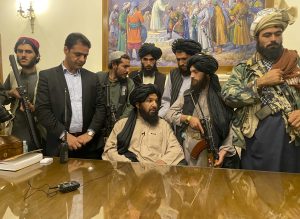That the Taliban are on the cusp of power in Afghanistan may be unsurprising, but the speed of the collapse is undoubtedly staggering. It appears that as the United States prepared to exit and the Ashraf Ghani government looked towards Pakistan to blame, the armed group was already planning how it would govern the country.
About 10 days ago, the Taliban claimed its first major victory when it overran the regional capital Zaranj in the southwestern province of Nimroz. On Sunday, its fighters entered the Presidential Palace in Kabul.
In just over a week, the Taliban seized 26 of the country’s 34 provinces, gained control of major border crossings, and choked Kabul. Although some areas such as Herat saw intense fighting with popular militia serving alongside the Afghan security forces, others such as Jalalabad witnessed armed forces and government officials surrender without a shot being fired.
If the past week is anything to go by, Afghanistan’s fall reads more like a story of the Afghan government’s weakness than the Taliban’s strength.
Even the Biden administration appeared to be caught off guard. The American establishment had deluded itself that the Taliban’s military presence was merely intended as “leverage” at the negotiating table, not grasping the fact that the armed group was determined to seize power by force.
On August 12, a U.S. defense official cited American intelligence predicting Kabul could be overrun in 90 days. That day, the Taliban took over Badghis, Ghazni, Herat, Helmand, and Kandahar provinces.
The next day, a diplomatic source told CNN that an intelligence report indicated Kabul could be isolated within 72 hours. Meanwhile, the U.S. Embassy in Kabul was told to “destroy sensitive materials as well as items.”
This report was on point.
The Taliban were at the gates of Kabul city early Sunday and in the evening Ghani relinquished power and flew to Tajikistan with Vice President Amrullah Saleh. Meanwhile, Afghan Interior Minister Abdul Sattar Mirzakwal announced a “peaceful transfer of power” to a transitional government.
It would be naive to assume the fall was impromptu. A 2018 BBC report showed that the Taliban had an active presence in several districts with about 15 million people – around half the population – living in areas controlled by the militant group. For years, the Taliban were running a parallel, shadow government.
The Taliban were not just cutting deals in Doha; they were also secretly reaching out to important leaders and Afghan National Defense and Security Forces (ANDSF) officials at the village, district, and provincial levels through family, friends, and tribal ties.
Ghazni governor Daud Laghmani, a close aide of Ghani, reportedly welcomed the Taliban commander with flowers while another Ghani ally and a former deputy speaker was appointed Kabul police chief by the Taliban.
Afghan journalist Bilal Sarwary believes much of the collapse is due to a disconnect between the Kabul leadership and battlefield commanders. The U.S. and allied forces’ withdrawal, coupled with the massive corruption that plagues the Afghan government and security forces, meant the soldiers were overworked and deprived of necessities such as food rations.
The division amongst politicians and milking of the peace process by the leadership had a “destructive impact on the psyche of soldiers.” As a result, many soldiers did not want to die for a “corrupt government.”
A quick look at recent developments in Kabul shows that the Ghani government was preoccupied with politics; in the past week alone, as the Taliban were making rapid advances, the Afghan leadership was busy trending hashtags to “sanction Pakistan” while Ghani blamed the country’s deteriorating security on the U.S. decision to abruptly withdraw its troops.
While Pakistan has taken credit for brokering the peace deal between the U.S. and the Taliban and wields some influence over the armed group, it can hardly be blamed for the fact that the Afghan security forces largely stepped aside to make way for the Taliban’s ascent.
On the other hand, the U.S. government’s breathtaking failure to build a cohesive fighting force in Afghanistan – despite spending $83 billion on training and equipment since 2002 – stands exposed.
Emboldened by the decreased footprint of foreign troops and exploiting the lack of leadership in Kabul, the Taliban have regained the power they were stripped of by the U.S. invasion 20 years ago. But the biggest price for all this chaos will be paid neither by the Kabul leadership nor the Biden administration. It is Afghan civilians who have been left on the brink of uncertainty once again.
A United Nations report estimates that nearly 400,000 Afghans have been internally displaced since the beginning of the year, when the Taliban launched offensive against the Ghani government, 244,000 of them since May alone. The U.N. Office for the Coordination of Humanitarian Affairs has verified that 10,350 IDPs arrived in Kabul between July 1 and August 12.
This is just the beginning of what appears to be another long conflict.

































